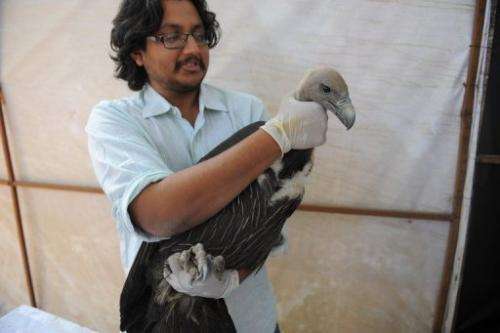S.Asian vultures stable after near-extinction, study finds

The population of South Asian vultures, which suffered a 99 percent drop since the 1990s, has stabilised for the first time, a study said, offering a glimmer of hope that the birds could be saved.
New research showed that a 2006 ban in India and Nepal on the bovine painkiller diclofenac had cut deaths among the three critically-endangered vulture species.
But researchers warned that the birds remained "extremely vulnerable" and more needed to be done to eradicate illegal use of diclofenac, which causes a fatal kidney ailment in vultures who feed on cattle carcases.
Three species are found on the Indian sub-continent—the oriental white-backed vulture, the long-billed vulture and the slender-billed vulture, collectively known as gyps vultures.
Their numbers crashed after diclofenac was introduced in the mid-1990s to treat colic in cattle, whose bodies are left in the open after they die and are a food source for the scavengers.
One of the study's authors, Richard Cuthbert from Britain's Royal Society for the Protection of Birds (RSPB), said the results were "really encouraging as previously populations were nearly halving in number every year".
Even though it is now illegal to import, make, sell or use diclofenac for veterinary purposes in India, a human version of the drug is still available and some people use it to treat animals.
"Efforts are still required to protect the remaining small populations, including stopping the illegal use of human diclofenac," lead author Vibhu Prakash said in a press statement released Saturday.
After India and Nepal banned veterinary use of the drug, scientists observed a continuing decline in vulture death rates in the region, according to an RSPB study published last year.
The new research did not give a current population estimate but in 2007 the Bombay Natural History Society estimated there were only about 11,000 white-backed, 1,000 slender-billed and 44,000 long-billed vultures left in India.
Their previous population was thought to number in the tens of millions.
The full study can be found at: www.plosone.org/article/info%3Adoi%2F10.1371%2Fjournal.pone.0049118
(c) 2012 AFP

















